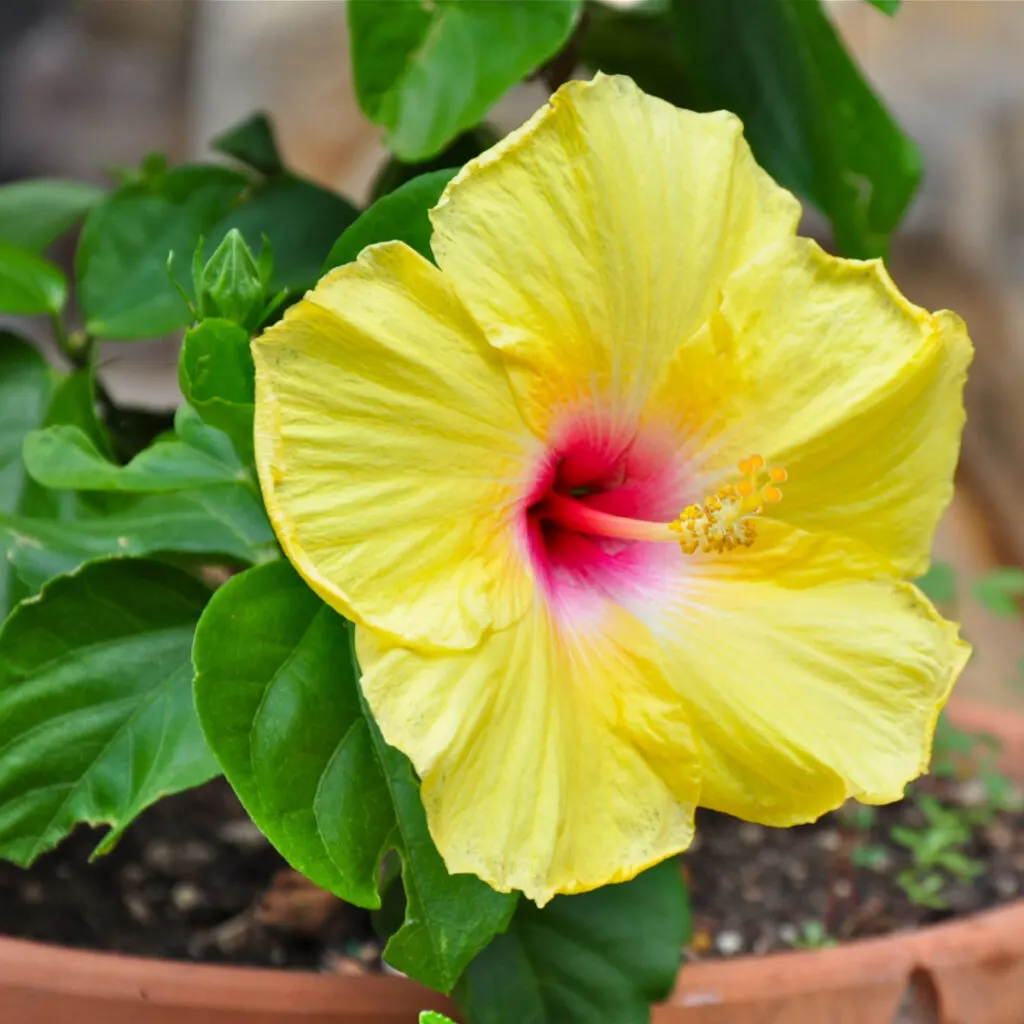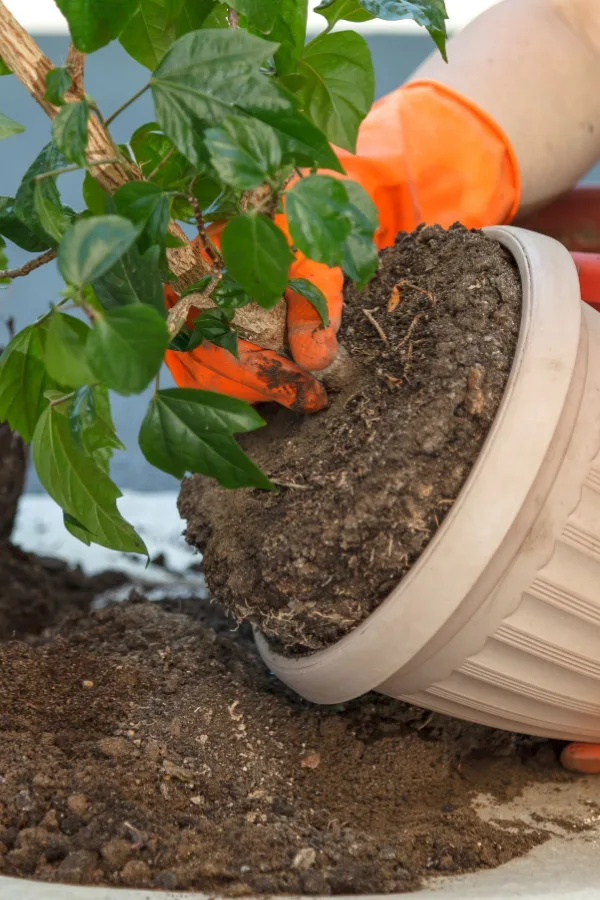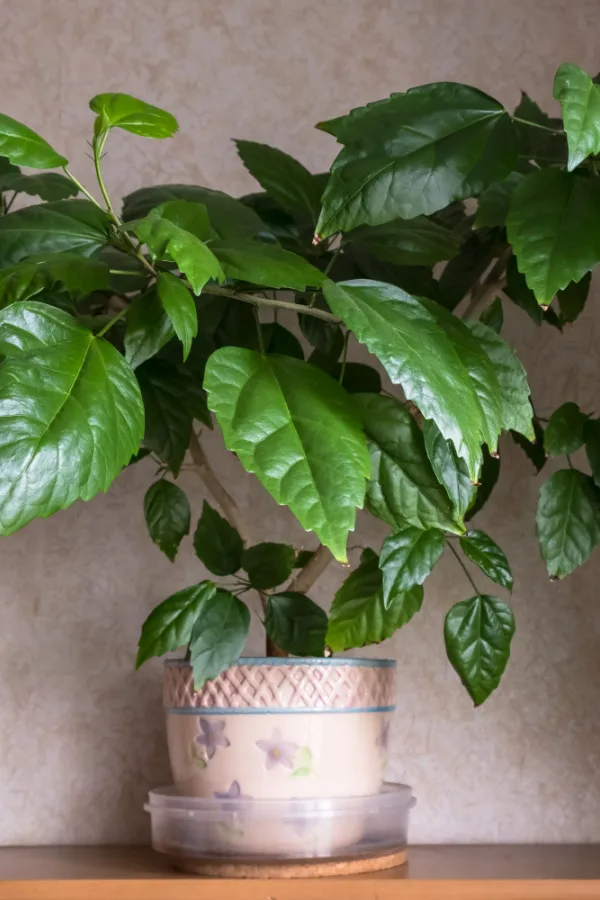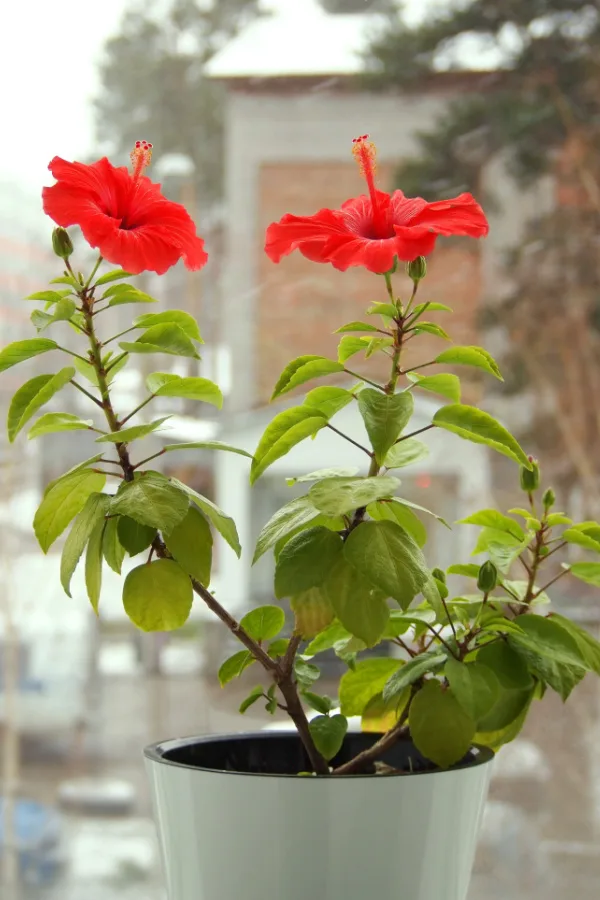Looking for a few tips and tricks to keep your hibiscus plants alive and thriving indoors this winter?
Hibiscus is a tropical plant featuring beautiful, glossy foliage and large intricate blooms in a variety of bold colors. They really are quite the showstoppers during the warm months in almost any growing zone. But in order for this gorgeous plant to survive the harsh, cold winter months, it needs to be brought indoors to stay alive.
Whether you are growing hibiscus in pots on your patio or deck, or directly in flowerbeds, these perennial plants truly flourish with the heat of summer. However, if you live in a location that experiences true winters, your hibiscus plants will quickly start to suffer if exposed to freezing temperatures.

The good news is that overwintering hibiscus plants doesn’t have to be difficult. Nor does it require an indoor greenhouse, special lights, or expensive equipment to successfully keep the plants alive and ready for blooming next year.
How To Keep Your Hibiscus Plants Alive Indoors Over Winter
Acclimating Hibiscus To Indoor Life
Success with overwintering hibiscus starts with getting the plant indoors early in the fall. Unlike other perennials that can be brought in right before a hard frost or freeze, a hibiscus plant is different.
For starters, its roots and foliage can suffer issues simply with cold soil. Because of this, it is best to not allow the plant to remain outside if temperatures drop below 50º Fahrenheit for any extended time.
If your hibiscus is growing in a pot or container, this is a simple, fast task. If a cold night is in the forecast, simply bring it in for overnight protection. However, if your plants are growing directly in the soil, you will need to dig them up and pot them in advance of any cold temperatures.
Digging Up Hibiscus Growing In The Ground – How To Keep Hibiscus Plants Alive Indoors
If you have planted your hibiscus in the soil, it should be dug and potted early in the fall. The ground unfortunately begins to chill by mid-fall. By getting the plant out while the soil is still warm, it will suffer less shock and have a much better chance of survival.

When digging out the roots, it is important to keep the soil ball as intact as possible. Since the plant will only be overwintering, the pot needs to be just slightly larger than the root ball.
When potting, select an all-purpose, loose, well-draining potting soil. Although hibiscus plants need a fair amount of moisture, potting soil that holds too much water will rot the roots. Place a bit of potting soil in the bottom of the pot and slightly moisten it before placing the root ball into the pot. Affiliate Product Link: Burpee Premium Organic Indoor Potting Soil Mix
Pack the soil around the ball as you continue to add more soil. Allow space for a light covering of mulch on top, as this will help keep the soil from drying out too quickly indoors. Finish by lightly watering the soil and plant so that it is slightly moist but not over saturated.
Bringing Plants Indoors – How To Keep Hibiscus Plants Alive Indoors
Whether you are starting with hibiscus plants already in containers or you just potted them up from your flowerbeds, you can continue to leave them outside on warm fall days.
The more late season sun and warmth they get, the better. This allows the plant to store more energy and keep its roots strong. This is especially important for plants that were just potted up. The important thing is to keep an eye on the forecast and bring them in if the temperatures will be dropping too low.
As fall temperatures start to cool consistently, it’s time to prepare your hibiscus for its permanent spot indoors. This will allow it to slowly adjust to less light. It also protects your hibiscus from exposing it to too much cold.

Winter Care – How To Keep Hibiscus Plants Alive Indoors
For best results, select the warmest, most well-lit room of the house for your plant’s winter home. Hibiscus plants do not have to sit in a window, but the closer they are to natural light the better. Avoid placing plants near vents or drafty windows. This can cause stress to your hibiscus and result in both leaf and bloom loss.
Depending on the amount of light and heat indoors, your hibiscus may continue to grow and even bloom. It can also go semi-dormant if there is not enough light or warmth.
If your hibiscus stays active, it will require more frequent watering. Plants that go semi-dormant will need only occasional watering. The best rule of thumb if your hibiscus goes semi-dormant is to never let the plant completely dry out.
If too many leaves begin to brown or fall off, it’s likely your plant is not receiving enough light, warmth, or both. In these cases, an ordinary fluorescent or LED bulb can help stimulate the plant. If you happen to have a grow light, it will work as well but the special light is not necessary to give the plant the light it needs.
If you simply don’t have enough room or light to keep the plant bright enough, you can also allow your hibiscus plant to go completely dormant in a cooler, dark room of the house.
Although this is an option for those with no sunny windows or available room, note that it can be difficult to bring a hibiscus out of dormancy in good health. For that reason, it’s best to keep the hibiscus plant active or semi-dormant when overwintering.
Pruning Hibiscus – How To Keep Hibiscus Plants Alive Over Winter
Like many perennials, hibiscus plants bloom on new growth each year. Because of this, it is best to only prune them in the spring. That allows for new stems and foliage to grow and sets the stage for new blooms.

When bringing hibiscus indoors in the fall, a bit of light shape pruning is fine. Simply cut back unruly stems or a few leaves here and there to make it fit your indoor space better. But beyond small cuts, leave any major pruning until spring.
Unfortunately, fall pruning can adversely affect future bloom cycles by promoting late growth. It can also put a fair amount of stress on the plant as it tries to regenerate new growth. This can be exceptionally hard on plants that are being overwintered since they will already have less light and warmth than usual.
Fertilizing – How To Keep Hibiscus Plants Alive Indoors
One of the best ways to keep your hibiscus healthy, vibrant, and blooming while you overwinter is regular fertilizing. Hibiscus plants perform best with a balanced ratio fertilizer of nitrogen, potassium, and phosphorous. Look for fertilizers with equal ratios like 5-5-5 or 10-10-10. Affiliate Link: Dr. Earth 1 lb. 5-5-5 All Purpose Fertilizer
All of these options will supply a fair amount of nutrients without overpowering the plant. Fertilize your hibiscus plant every 3 months for best results. Early spring, mid-summer, late fall, and mid-winter is a good rule of thumb.
You can also use compost tea monthly as an alternative fertilizing approach. With balanced nutrients in a liquid form, it works well for keeping your hibiscus healthy without overpowering the plant. (See: How To Make Compost Tea)

When the weather starts to warm up in the spring and stays consistently above 50º F, start to bring your hibiscus plant outside. Place it in a protected warm, sunny location for a few hours each day. Slowly increase that time to help re-acclimate the plant for outdoor living once again.
Here’s to taking the time to overwinter your hibiscus this year and enjoying the beauty of this tropical plant all year round!
Follow Our Facebook Page For Great Gardening Tips And Advice! This Is My Garden Facebook Page
This Is My Garden is a garden website created by gardeners, for gardeners. Jim and Mary Competti have been writing gardening, DIY and recipe articles and books and speaking for over 15 years from their 46 acre Ohio farm. They publish three articles every week, 52 weeks a year. Sign up today to follow via email, or follow along!
